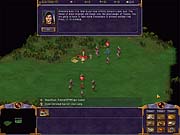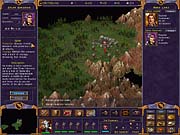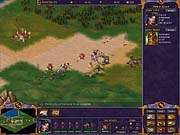Kohan: Immortal Sovereigns Preview
We've got a beta build of Kohan. Read on for our impressions of this strategy/RPG hybrid.

Kohan: Immortal Sovereigns is an intriguing real-time strategy game that offers a dose of role-playing and some of the good old-fashioned addictive qualities that the Heroes of Might & Magic series brought to the table. The game is currently scheduled to ship next month, but we recently had the opportunity to play around with a late beta of this fantasy empire-builder. Although the demo version we tested offered only a pair of tutorial campaigns and a skirmish battle mode, enough of the game's slick and complex design was in place to leave a favorable impression. When it is complete, Kohan should strike a near ideal balance between originality and tried-and-true RTS elements.

At heart, Kohan is very similar to the Heroes of Might & Magic series. You strive to build cities from which you can send armies on errands of exploration and conquest. The landscape contains numerous enemies and neutral parties as well as ancient ruins to explore and many other interesting diversions. Not much of the single-player game is in place at the moment, but the multiplayer design (as illustrated in the skirmish mode) is a very solid RTS experience. In fact, Kohan skirmishes blend together several key elements of both the Heroes of Might & Magic titles and Microsoft's Age of Empires games--not bad company, all things considered.
Like in the Heroes of Might & Magic series, heroes play a critical role in Kohan. In fact, the game's subtitle (Immortal Sovereigns) hints at the underlying theme of the action. As players construct cities, recruit armies, and set out in search of new lands to conquer, they may discover Kohan amulets scattered about the world. These let players summon immortal heroes from an earlier age. As you might guess, Kohan heroes generally have special abilities and can make armies more formidable in battle. Best of all, these heroes are immortal, so if they happen to die in battle, you can always bring them back for a mere 50 gold pieces (presumably a resurrection service charge).
Heroes are only a small part of the complex army system at work in Kohan, however. Although you want to have heroes leading as many armies as possible, it is even more important to assemble your armies in an intelligent and tactically sound way. Each army--or company--consists of a leader, a main body, and two supporting groups. If you have a Kohan hero available, you can designate it as the leader of a company. Otherwise, a generic general will be placed in charge. Then you choose the type of unit you want for each "wing" of the company. Unit types range from basic footmen and scout cavalry to more powerful forces like archers, warlocks, grenadiers, and heavy cavalry. When you recruit and commission a company, it will appear in the gameworld with only two members: the leader and the first member of the main body. The longer you let the company sit idle near a friendly town, however, the more powerful it will become.
Zones

This is the effect of the town's supply zone, an area surrounding any settlement in which companies may be supplied with fresh troops. The zone can be made visible on the screen as a white region radiating out from the town. The larger the settlement, the wider the zone of supply. As it sits within a zone of supply, a company will increase in strength until it reaches the makeup you outlined on the company commission menu. The same effect holds true after a company is depleted by battle. Even if all members of the company except one are wiped out, the entire company will eventually regenerate once you move the force within a friendly town's zone of supply.

Kohan also uses a few other zones to affect gameplay. Each company, for example, has its own zone of control, which determines how far the company can "see" and when it will enter into conflict with other military forces. Certain unit types increase a company's zone of control--scouts, with their increased viewing range, are a good example. When a company's zone of control overlaps another hostile company's, the two will engage in battle. Similarly, when a company's zone of control overlaps an unexplored ruin, that ruin will automatically be explored, and whatever treasure it contains (gold, a Kohan amulet, or some helpful technology or information) will automatically be added to your war effort.
Combat in Kohan is exciting and often highly tactical. The game offers four unit formations, and the way in which you position your troops is almost as important as how they are led and what units compose the companies. Column formations (regular and pressed) are poor for combat, while the skirmish and combat formations are more effective but result in slower movement speeds for your companies. Fortunately, you can switch formations on the fly, so you can move a company along in column formation and quickly shift to combat formation when an enemy comes into view.
The Kohan heroes themselves play a critical role in battle, and you can set them to either command a company or engage the enemy. In command mode, Kohan heroes boost morale and (when applicable) cast spells to increase the overall effectiveness of the company. When set to engage, your heroes will wade right into a melee and add their strength to the battle. Since each Kohan is different, you have to choose different tactics for each hero. Warrior Kohan can be very helpful in a melee, while spellcasting Kohan might be more effective casting spells from afar.
Towns

The construction of towns in Kohan can be a complex--or at least time-consuming--task. The options are simple enough, and you do not need to micromanage the day-to-day functions of any settlement, but the need to continually upgrade and/or expand your towns can be a challenging task. Most settlements begin as simple villages in which you can build a single component. These include wood mills, quarries, blacksmith shops, and the like. Each component--surprise, surprise--adds to a town's resource-generating ability, and some (such as the blacksmith and barracks) allow for more military unit types to be generated by the town.
Towns can be upgraded for a price after a specific number of components are in place and, in some cases, after one or more of the components themselves have been upgraded. Upgraded towns provide many benefits, including a larger zone of supply, more component slots, and higher tax revenue. The upgraded components, on the other hand, have more specific benefits. For example, you can upgrade a quarry to a stone export. This will generate extra income but limit your ready supply of stone for other uses. Alternatively, you could upgrade the quarry to a mining post, which generates much more stone but no additional cash. Upgrades to components are mutually exclusive, so you cannot have a stone export and a mining post in the same town. This leads to some tough decisions down the road when you may have to sell off a highly specialized upgrade in favor of its simpler, basic-level component.

Militia is another aspect of a town that improves with the settlement's size. The larger a town becomes, the more sizeable the militia force it will have at its disposal. Militia is perhaps the coolest feature in Kohan, since it effectively frees you from the task of patrolling the area around each and every settlement you build or conquer in the game. Militia is generally made up of the basic unit available to you--footmen, for example--and responds automatically to any hostile forces in the area. So if an enemy company comes too close to your city, the militia will emerge and engage the offenders. Even small towns have a decent level of protection through the militia, while large cities can field a very formidable force if attacked.
Kohan's graphics are sprite-based and generally quite good. Individual units are well animated and easy to identify even with the game's somewhat distant view of the action. The terrain is very well rendered and hinders unit movement appropriately when you try to march your armies through thick forests or over hills. Cities burn when damaged and crumble to ashen hulks when razed. Dead units quickly but gradually fade to skeletons and then to nothing. Taken as a whole, the visual quality of Kohan is very impressive and very refined. Even the menu buttons are nicely designed, well laid out, and easily identified.
The game's tutorial mode, which may or may not be complete, is well implemented as well. If this tutorial stays as it is in the demo version, newcomers to the game will have no problem picking up the various features and complexities of Kohan. The game also includes a map editor, which is surprisingly easy to use and provides a wealth of interesting goodies to place in custom multiplayer or skirmish maps.
The missing--and rather critical--element in all of this is the game's single-player campaign (or campaigns, as the case may be). But based on the level of quality to be found throughout this preview version of Kohan, we're hopeful that the single-player aspect of the game will be at least as good as what we've seen so far. If it is, there is little doubt that this game will take up semipermanent residence on many RTS fans' hard drives.
Got a news tip or want to contact us directly? Email news@gamespot.com
Join the conversation